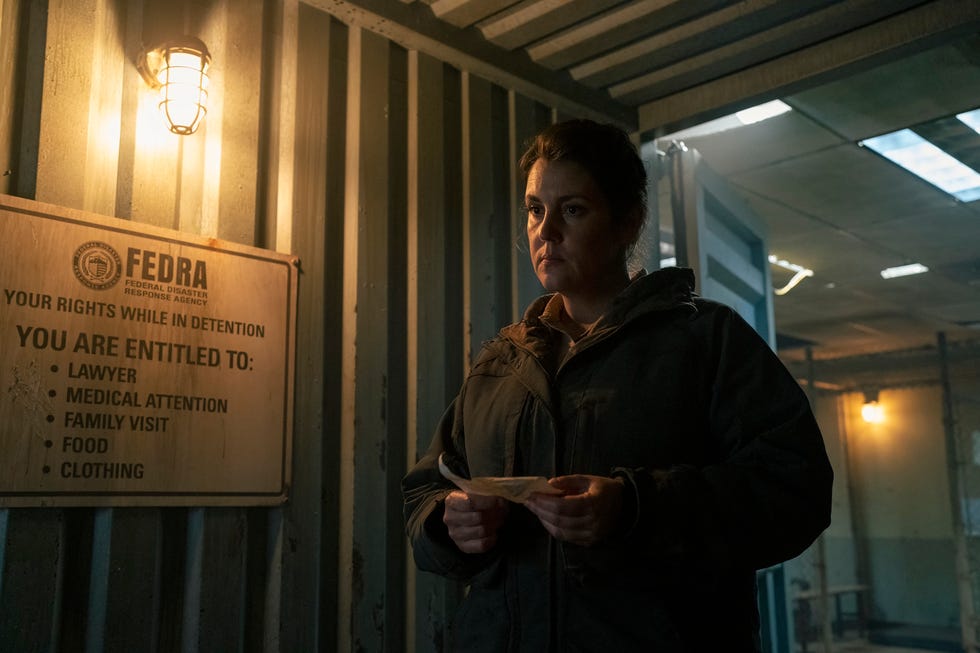So far this season on The Last of Us—Craig Mazin and Neil Druckmann’s adaptation of the 2013 video game also written by Druckmann—fidelity to source material has been near absolute. With dialogue lifted from the game’s screenplay and sequences filmed and edited to match several cutscenes, The Last of Us may be the most narratively and aesthetically faithful video game adaptation in some time. Maybe ever. (Ignoring Halo’s attempts at recreating fist-person shooting gameplay.)
Deviations thus far this season have mostly included rounding out peripheral characters from the game—with Episode 3 unspooling the tale of Bill and Frank, two characters who appear only momentarily during events of the video game.
In Episode 4, the co-writers introduce the first substantial addition to source material in the character of Kathleen (Melanie Lynskey), the leader of a rebel-like military force.
Mazin and Druckmann spoke about the decision this week on The Last of Us Podcast, with Druckmann explaining what Kathleen’s character allows the series to now accomplish: “The show affords us the ability to leave Joel and Ellie and flesh out other characters in different ways. The best thing I think you can do in The Last of Us is flesh out your antagonist to show that there’s a motivation behind what they are doing.”
That antagonist—Kathleen—is a significant addition to the world of the series, if only because it introduces a kind a villainy the game never explores. Mazin compared Kathleen to Madame Defarge in A Tale Of Two Cities, highlighting the writerly decision for some moral ambiguity. (Defarge is both a revolutionary and antagonist in Dickens’ novel.) Druckmann on this type of character: “They don’t see themselves as villains or the bad guys. We are just at odds with each other because our goals somehow overlap what we want which are different things.”
But unlike the Bill and Frank storyline, this departure from the game seems less successful.
Is Kathleen in The Last of Us video game?
While we meet a band of militarized civilians in the 2013 video game—they’re called the “hunters”—we learn nothing about their motivation or leadership structure; it’s assumed they successfully challenged government control following the outbreak. That’s about it. They’re presented mostly as goons to be dispatched by Joel and Ellie on their way through Pittsburgh.
Kathleen is the imagined leader of this group (in the series, these events take place in Kansas City). She does not appear in the video game, though her position is assumed; someone must be leading the hunters.
By introducing Kathleen, the series hopes to give the hunters a face—as well as motivations, grievances, etc.
Kathleen as antagonist, however, seems to accomplish the opposite. Her presence introduces a kind of specific villainy the video game often avoided. Evil in the game appears in moments of desperation—people Joel and Ellie meet along the rode who act out of pure self-preservation. (Like many apocalyptic narratives, tension exists in trust.) While the player does murder many hunters, these individuals are never presented as amoral men, and some levels can be accomplished without killing the hunters; the game forces the player to make that moral decision. (Which implicates Joel more than it does the hunters; Joel too is only acting out of self-preservation.)
By introducing Kathleen, the show is ironically marching closer to binaries (right and wrong) than the relativism they likely want her character to reflect. Unlike the begging boy Joel must kill when reaching Kansas City—a scene that more than humanizes the hunters—Kathleen is pure antagonist. She may have her motivations, but they do nothing to soften our judgements of her actions, nor do they complicate our view of who we should be rooting for.
If anything, Kathleen relieves viewers from the discomfort of having to judge Joel and Ellie’s equally dubious decisions.
Assistant Editor
Joshua St Clair is an Assistant Editor at Men’s Health Magazine.



Comments are closed.